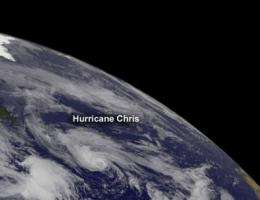NASA sees Chris become first hurricane of Atlantic season

NASA satellites monitoring the life of Chris in the Atlantic saw the tropical storm become the first hurricane of the Atlantic Ocean season on June 21, 2012.
Infrared satellite imagery from NASA's Aqua satellite have revealed that the clouds around Hurricane Chris' eye have reached a cold peak early on June 21 when it was first designated a hurricane, and have since warmed. The thunderstorms that surround Chris' eye are now between -60 and -70 Celsius. Cloud top temperatures that cold indicate strong, high, thunderstorms with the potential for heavy rainfall.
When thunderstorm cloud tops cool, it means there's more uplight in the atmosphere, which can push cloud tops higher and build stronger thunderstorms. When cloud top temperatures warm, it means the cloud tops are falling, and the push of the air upward is lesser than it was before, and the storm is weakening. As a result, forecasters at the National Hurricane Center expect Chris to become a post-tropical cyclone on Friday, June 22. That weakening is expected because Chris is moving into stable air and cooler waters.
NOAA's GOES-13 satellite captured a visible image of Chris on June 21 at 1445 UTC (10:45 a.m. EDT). The image was created by NASA's GOES Project at NASA's Goddard Space Flight Center in Greenbelt, Md. and it showed Hurricane Chris with a tight circulation center.
At 11 a.m. EDT, Chris had 75 mph (120 kph) winds. It was located about 625 miles (1005 km) southeast of Cape Race, Newfoundland, Canada, near 41.1 North and 43.2 West. It was moving to the northeast at 20 mph (32 kph) and had a minimum central pressure of 987 millibars.
Chris is expected to turn in the Altantic over the next couple of days. First a turn to the north and then northwest and finally south. Chris is moving around a large mid-to-upper level low pressure area and will eventually become absorbed within the upper level low in the next couple of days.
Provided by NASA's Goddard Space Flight Center



















